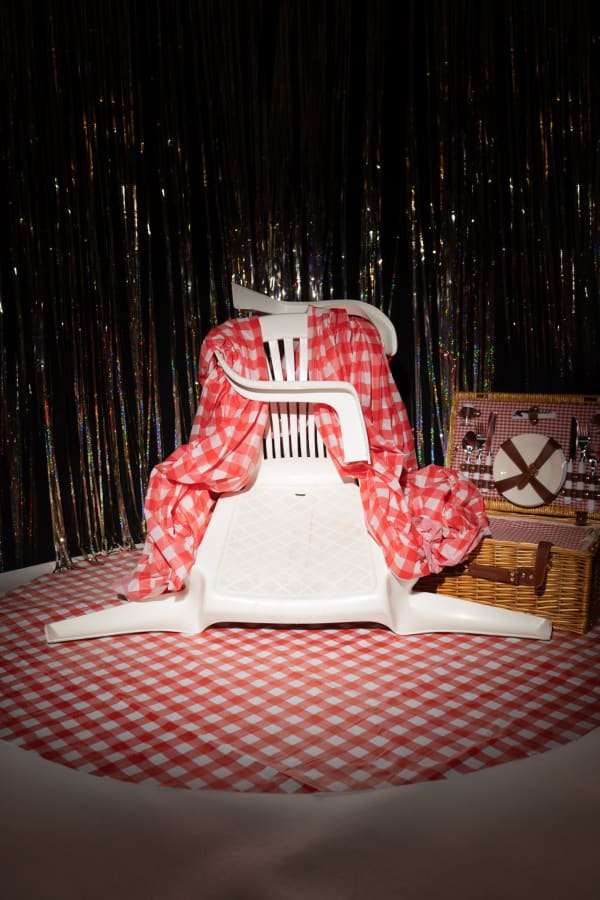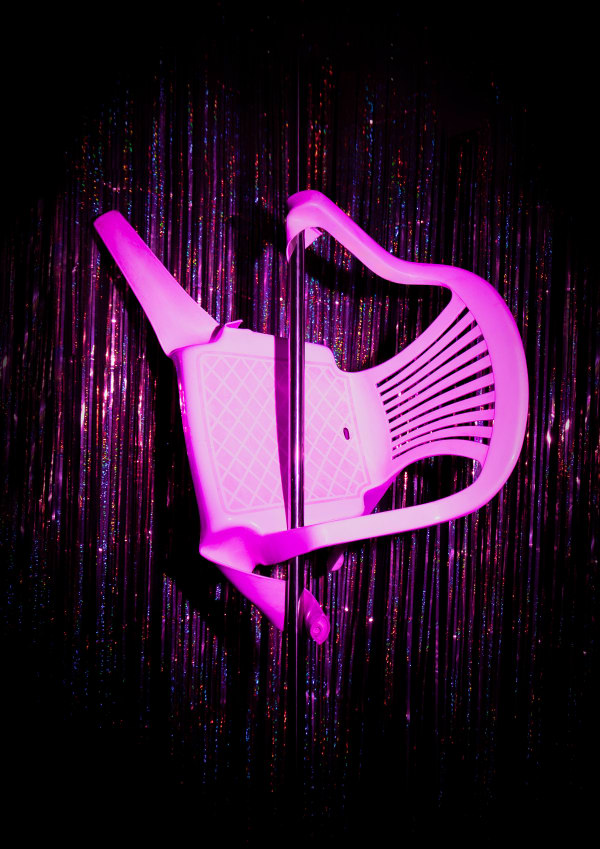Ty Locke: Under the Table
Previous exhibition
Text
“Thank god I'm gay and thank god I'm an artist
because I would much rather be here than there.”
-Ty Locke
Within a deeply personal sculptural practice Ty Locke explores aspects of biography relating to domestic relationships, queer culture and social systems with a humour juxtaposed with the emotional depth and tone of the topics they explore. Through the alteration of mundane objects and by disrupting their materiality and function to create labour intensive sculptures, Locke imbues his work with layers of personal and social evaluation. In his first European solo exhibition Under the Table, Locke explores his relationship with domestic spaces, particularly his connection to his upbringing. As the eldest child of seven born in Kent, Locke and his family moved consistently throughout his childhood leading an itinerant lifestyle characterized by instability due to his mother’s mental health and corresponding substance abuse difficulties. In conjunction with this, the exhibition also engages with Locke’s queer identity and how these biographical elements co-exist in both accordant and conflicting manners. For Locke the underlying fear he held as a child and an instinct for survival is closely related to the feelings he has as an adult queer person, at first navigating anxieties and unfamiliarity before discovering his own agency to engage with queer dialogue. Under The Table explores these two aspects of the artist’s life as a means to arrest ownership over them with compassion, turning the feelings of alienation into a unique commentary on social inclusion, chosen families and personal versus socio-economic identity.
Upon entering the exhibition, the viewer is met with ‘Randall Shoe Rack’ and ‘Mum Puffer Jacket’ both of which contain photographs painstakingly cropped and collaged onto the material across the composite items. The pieces exist in tandem with one another with ‘Mum Puffer Jacket’ containing images of the artist’s mother while pregnant and ‘Randall Shoe Rack’ photographs of Locke’s pregnant childhood dog. The objects hold a memory of his childhood, when Locke would help his mother cut out the images for collages while never being allowed to do the placement on the thematically ordered boards. The works hold a contemplation on aspects of intergenerational trauma and familial patterns, with the repetitive concentration on parenthood acting as an attempt to comprehend a disconnect with this integral relationship.
Throughout the domestic objects within the exhibition, a motif of embedded items, holes and ingrained objects emerges. For Locke, this motif explores the idea of a sense of permanence where objects are stuck and rooted into another, an attempt to ground a feeling of instability, the action of which is ultimately subverting the inherent integrity of the material. One particular piece in this regard is ‘Under the Table’, composed of a small side table with related paraphernalia including a whiskey glass, cigarettes, wine bottle and beer cans. Each of the objects are impaling the table through an array of circular holes carved into the surface creating the impression of planets circling one another in individual magnetic orbits. On the one hand the work can be read as a still life, encapsulating destructive items that infiltrate the home contributing to isolation and self-destruction. However, there is also an anthropological aspect to the piece, arranged like an echo of communal home, the traces of different people and conversations that would have occurred alongside the corresponding consumption. Towards the back of the exhibition space is ‘Laying the Table’ consisting of several plates arranged as though on display with fragmented areas of each plate cut out and cutlery embedded and protruding from the ceramic as though left there thoughtlessly after a meal. On one wall hangs seven plates corresponding to the artist’s siblings with the adjacent wall holding a singular plate representing the artist’s mother. As with ‘Under the Table’ each of the plates creates the impression of a planetary arrangement, or a series of atoms orbiting one another, pulling away and towards each other simultaneously.
Alongside this is ‘Peep Hole Door’ consisting of a front door placed across the exhibition floor containing a myriad of peep holes embedded across its surface. Within this piece, Locke considers the expectation of privacy and safety in the home as a contrast to his reality growing up where the family felt constantly on view due to the frequent and unannounced visits of social workers. Thus, apart from one peephole that faces outwards, each of the holes are arranged with a view inward, infiltrating and intruding inside. The thread of dysfunction within the domestic environment lingers through ‘Codependent Broom’ and ‘Codependent Dustpan Brush’, each composed of two brushes with the bristles removed from one and arranged in a spiked fashion in the other. The works speak to a form of codependence with both items negated of purpose with one draining the resources of the other though in actuality creating its own lack of functionality. Again, here we see the subversion of materials disrupting function and creating a metaphoric tethering between objects, people and emotions.
‘4th-5th June 2015’ consists of a mirror etched with a diary entry from his mother’s stolen diary from exactly ten years before the opening of the exhibition. The work creates the question for the artist of whether his mother would have attended the show and written about it in her diary were they not estranged. Written shortly before he became homeless, Locke and his first boyfriend are mentioned within the diary entry, posing a further contemplation upon one of his first gay relationships and the contrast with his current existence. In conjunction with this, the final work upstairs is a pair of black Wellington boots intricately carved into, creating the pattern of fishnet tights. Subtly tucked away by the door as if ready to be worn and the door exited, ‘Fishnet Wellies’ acts not so much as a transition from the childhood domestic environment of the artist, but rather as a seed or a provenience of a joyous queerness that lay beneath the surface.
The viewer is then drawn downstairs into a darkly lit basement past posters suggestive of adverts for drag performances mimicking past events of this imagined venue. Within the room they are met with a series of melted plastic chairs arranged as though in a sex club. The voyeur, the exhibitionist, the submissive and the dominant are all in attendance, linked to one another in overt sexual poses and positioning. The room is lit only by a dimmed neon sign constructed out of a chair with a flashing flaccid and erect penis, combined with the colour emanating from light boxes containing further posters of anthropomorphized chair drag queens, one spinning around a pole and the other surrounded by picnic trappings. Within the composition of the chairs are several intimate moments as the chairs embrace but also elements of uncertainty and anxiety within the space. The mood reflects the artist’s relationship to his queer life as an adult, a world that was initially intimidating with no one to educate him or explain codes and situations. However, throughout the composition of the space there is also an exuberant humour, an unapologetic joy in the freedom of agency and individuality. Upon wandering around the basement, the viewer becomes party to the antics and seductions of the characters, welcomed into an environment enclosed from outside judgement and unconstrained by heteronormative sexual-social rules. We are thus encouraged to consider the significance of queer spaces both in the freedom they aim to grant and the protection they offer for exploration of one’s identity.
*
Ty Locke (b. 1996, Maidstone, UK) currently lives and works in London. Locke graduated with an MFA in Sculpture from Slade School of Art, London in 2023 and a BA First class from the University of the Creative Arts, Canterbury in 2018. Recent exhibitions include: ‘The Pleasure of Misuse’, Royal Society of Sculptors, curated by Indira Dyussebayeva-Ziyabek and Maria Hinel, 2025; ‘Matching Seats’, MAD Museum, Brussels, Belgium, 2025; 'Take a Seat', Bow Arts, London, 2024; 'Intension (the concept of 'dog' encapsulates its 'dogness', Copperfield, London, 2024; 'Fragment I, COMMUNE, Vienna, 2024; ‘Kitchen Sink Drama’ (solo), Copperfield, London, UK, 2023; ‘Annual Sadness’, The Organ Factory, London, UK, 2023; ‘Amber Room’, Matt's Gallery, London, 2023; ‘Unfurnished’, Bomb Factory, London, 2023.
Locke’s work is included in the following collections LAM Museum, Netherlands; Ingar Dragset, Germany; Maarten Baas, Netherlands; Sigrún Davíðsdóttir, UK and he was a recipient of the Platform Graduate Award, Turner Contemporary, Margate, 2018.
Installation Views
Works














